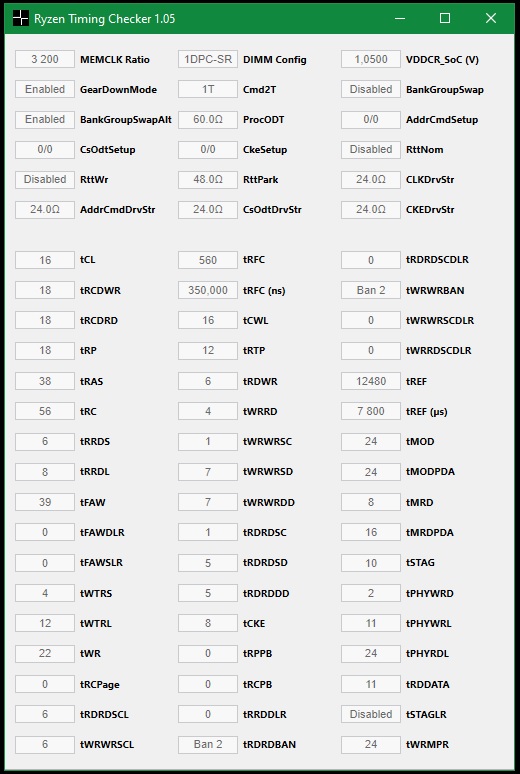Please post your stable CJR timings first.
I wanted to start a thread for everyone to share their timings, tips and tricks with the newer Hynix CJR ram.
If you know anything about it, you'll know that info is scarce online about these chips and they are capable of some really great speed.
I have the G.Skill Ripjaws V 3600 19-20-20 F4-3600C19S-16GVRB chips and I'm currently trying to get it to boot past 3200!
Doing memtest as we speak at 3400 currently at 16-17-17-38-56 1.37v.
On my Ryzen 1700x the 3600 xfr is a no go for me sadly.
So if you have CJR, post up your timings and settings that you're stable at and hopefully we can all get through this together.
Here's my memory dump:
![Image]()
Found this on another thread that may help:
"In my experience, the Ryzen DRAM Calculator should be used as a learning program (at least for now since there's no CJR support), and yeah CJR is pretty new and there not much information about it now.
So, what I learned OC'ing this RAM is that you should increase the timings each 200MHz-400Mhz overclock (If it's cl15-15-15-15 at 3000, you should increase it to cl16-16-16-16 at 3200, and so on) and tRAS by +2 or +3 (if it's 35 at 3000, it should be 37-38 at 3200). The procODT is very sensitive aswell, I can run at 60 Ohms at stock speed, but if I increase to 3200 I should decrease the procODT to 53 or even 48 Ohm. RttNom should be 34 Ohm or less (preferably off if OC'ing more than 400MHz), RttWr should always be off, RttPark works best (at least with me) at 48 Ohms or lower. The CAD BUS Driver Strengths should always be 20 Ohms (maybe 24 Ohms if you're not doing any agressive overclock).
tFAW really helps aswell, it should be DRAM Speed/100, (so, 3000MHz would be 30 tFAW) maybe increase or deacrease a little bit for better stability. My chip really loves low voltage, it's semi-stable at 3466MHz with 1.37v. And finally this chip really loves 2T aswell, and it doesn't seem to have any significant difference in performance compared to 1T (the difference is up to 2% in performance impact with sinthetic benchmarks, so basically 0% performance impact on real-world applications) so if you can't get it stable at 1T (even with geardown), stick to 2T be cause you'll probably be more than fine with it.
Note: procODT is REALLY sensitive with voltages, high procODT and High Voltages crashed, low procODT and low voltages doesn't work, medium procODT and medium voltages work with a little bit of tweaking."
I wanted to start a thread for everyone to share their timings, tips and tricks with the newer Hynix CJR ram.
If you know anything about it, you'll know that info is scarce online about these chips and they are capable of some really great speed.
I have the G.Skill Ripjaws V 3600 19-20-20 F4-3600C19S-16GVRB chips and I'm currently trying to get it to boot past 3200!
Doing memtest as we speak at 3400 currently at 16-17-17-38-56 1.37v.
On my Ryzen 1700x the 3600 xfr is a no go for me sadly.
So if you have CJR, post up your timings and settings that you're stable at and hopefully we can all get through this together.
Here's my memory dump:

Found this on another thread that may help:
"In my experience, the Ryzen DRAM Calculator should be used as a learning program (at least for now since there's no CJR support), and yeah CJR is pretty new and there not much information about it now.
So, what I learned OC'ing this RAM is that you should increase the timings each 200MHz-400Mhz overclock (If it's cl15-15-15-15 at 3000, you should increase it to cl16-16-16-16 at 3200, and so on) and tRAS by +2 or +3 (if it's 35 at 3000, it should be 37-38 at 3200). The procODT is very sensitive aswell, I can run at 60 Ohms at stock speed, but if I increase to 3200 I should decrease the procODT to 53 or even 48 Ohm. RttNom should be 34 Ohm or less (preferably off if OC'ing more than 400MHz), RttWr should always be off, RttPark works best (at least with me) at 48 Ohms or lower. The CAD BUS Driver Strengths should always be 20 Ohms (maybe 24 Ohms if you're not doing any agressive overclock).
tFAW really helps aswell, it should be DRAM Speed/100, (so, 3000MHz would be 30 tFAW) maybe increase or deacrease a little bit for better stability. My chip really loves low voltage, it's semi-stable at 3466MHz with 1.37v. And finally this chip really loves 2T aswell, and it doesn't seem to have any significant difference in performance compared to 1T (the difference is up to 2% in performance impact with sinthetic benchmarks, so basically 0% performance impact on real-world applications) so if you can't get it stable at 1T (even with geardown), stick to 2T be cause you'll probably be more than fine with it.
Note: procODT is REALLY sensitive with voltages, high procODT and High Voltages crashed, low procODT and low voltages doesn't work, medium procODT and medium voltages work with a little bit of tweaking."






